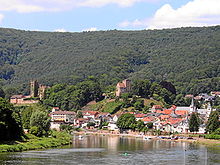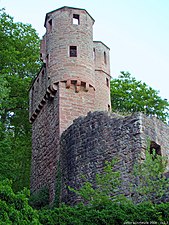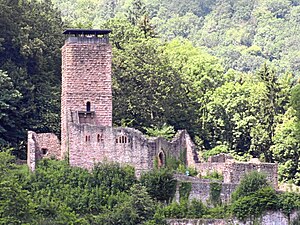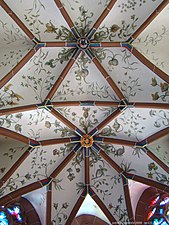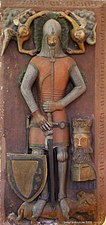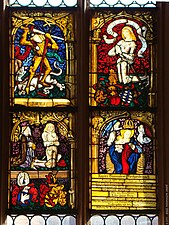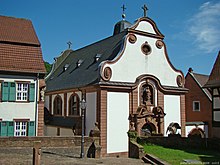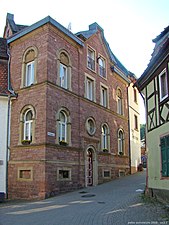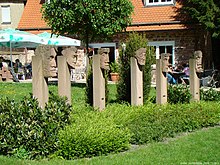Neckarsteinach
| coat of arms | Germany map | |
|---|---|---|

|
Coordinates: 49 ° 24 ' N , 8 ° 50' E |
|
| Basic data | ||
| State : | Hesse | |
| Administrative region : | Darmstadt | |
| Circle : | Mountain road | |
| Height : | 120 m above sea level NHN | |
| Area : | 17.23 km 2 | |
| Residents: | 3860 (Dec. 31, 2019) | |
| Population density : | 224 inhabitants per km 2 | |
| Postal code : | 69239 | |
| Area code : | 06229 | |
| License plate : | HP | |
| Community key : | 06 4 31 018 | |
| LOCODE : | DE NST | |
| City structure: | 4 districts | |
City administration address : |
Hauptstrasse 7 69239 Neckarsteinach |
|
| Website : | ||
| Mayor : | Herold Pfeifer ( SPD ) | |
| Location of the city of Neckarsteinach in the Bergstrasse district | ||
The four-castle town Neckarsteinach is located on the Neckar in the southernmost part of Hesse , in the Bergstrasse district , 15 kilometers east of Heidelberg . The southernmost point of Hesse is in the urban area.
Name and coat of arms
The city takes its name from the fact that the Odenwaldbach Steinach flows into the Neckar here . The city coat of arms goes back to the minstrel Bligger von Steinach , who already had a harp in the coat of arms.
geography
location
In terms of traffic and culture, Neckarsteinach is more closely connected to the Electoral Palatinate area around Heidelberg than to the rest of Hesse due to its location in the Neckar Valley . Like the surrounding districts, it is also one of the municipalities of the Rhine-Neckar triangle . It is mainly located on the north bank of the Neckar along the B 37 and the Neckar Valley Railway and is the southernmost town in Hesse and the Bergstrasse district , 15 km east of Heidelberg. Along the branching off former railway line to Schönau , another settlement center was built to the northwest, behind the castle hill, so to speak. In the eastern part of the village, there is a smaller industrial area that has arisen from shipbuilding ( shipyard ) south of the B 37 on the Neckar floodplain.
The center of Neckarsteinach is located southeast below the Vorderburg, with which the place was surrounded by a common wall as a castle hamlet from the 14th century. The place was bordered in the north and east by the Steinach, in the south by the Neckar and in the west by the Burgberg. The landscape near Neckarsteinach is characterized in particular by the cone of the Dilsberg mountain fortress (zu Neckargemünd , Baden-Württemberg ) on the opposite side of the Neckar, around which the Neckar forms a generous loop.
Neckarsteinach's districts of Darsberg and Grein are old settlements up the slope to the north in the Odenwald; the district Neckarhausen is 3 km upstream in the Neckar valley (not to be confused with the much larger district of Edingen-Neckarhausen west of Heidelberg , also located on the Neckar, of the same name ).
Neighboring communities
Neckarsteinach borders in the northeast on the Hessian town of Hirschhorn ( Bergstrasse district ) and the Hessian, community-free area Michelbuch . Neighboring residents of the Rhein-Neckar district in Baden-Württemberg are the municipality of Schönbrunn in the east, the city of Neckargemünd in the west and the city of Schönau in the northwest .
City structure
Population of the districts: (as of May 9, 2011)
- Neckarsteinach: 2634
- Darsberg : 513
- Grein : 129
- Neckarhausen : 231
- Total: 3804
history
The earliest human settlement of Neckarsteinach probably took place in prehistoric times, because the water and wooded area was ideal for hunters and fishermen who may have settled in the location protected from cold north and east winds. In the 7th century the area around Neckarsteinach belonged to the Lobdengau and came with this to the bishopric of Worms , as whose liege Bligger von Steinach was first mentioned in 1142. Worms or Bligger and his sons and grandchildren built the four Neckarsteinach castles, with whose history the local history is closely linked.
In the 14th century the place was surrounded by defensive walls by the Landschad von Steinach , whereby the joint walling of the Vorderburg and the city created a closed fortress. Half of the city belonged to the owners of the Vorderburg and the Hinterburg . Neckarsteinach was first mentioned as a city in 1377 and at the same time became the open house of Count Palatine Ruprecht , who was able to use the city as liege lord in the event of a feud against anyone except the Bishop of Worms. The first town hall was built in 1381, and in the first half of the 15th century Neckarsteinach was given town regulations, which were changed and supplemented in the following years. The oldest preserved town order dates from 1537.
Since Hans III. Landschad von Steinach professed Lutheran doctrine as early as 1522, the Reformation in Neckarsteinach was carried out very early: in 1526 the Lutheran preacher Jakob Otter was appointed to the place.
The city was badly affected in the Thirty Years War . The Catholic League under Tilly took after the conquest Ladenburgs in autumn 1621 also Neckarsteinach one from where the opposite in April 1622 mountain Dilsberg was besieged. After the Catholic troops withdrew to Sinsheim for a short time, they returned after the battle of Wimpfen and lodged in the city, where the plague broke out. In 1631 the Bavarian occupation troops were driven out by Swedish troops before imperial troops were in the city in 1634. At this time there was also another wave of plagues.
After the Landschad von Steinach died out in 1653, the dioceses of Worms and Speyer initially appointed feudal administrators, of whom the Speyer family lived in the rear castle. In 1657 the episcopal fiefs were given to Wolf Heinrich Metternich von Burscheid, a relative of the Archbishop of Mainz, who also acquired the allodial goods from the Landschad inheritance. Metternich was an old believer and encouraged the settlement of other Catholics. As a result, the Neckarsteinach Church was used as a simultaneous church for up to three denominations from 1662 to 1908 . In the Palatinate War of Succession , French, Saxon, Kurbrandenburg and Bavarian troops crossed the Neckar Valley, which were to be quartered and to which contributions had to be paid.
After 1685, many "Welsche", reformed Huguenots who had been expelled from France because of their faith , settled in Neckarsteinach. These were cloth makers and tanners, which meant that the city experienced a certain economic boom after the losses of the previous wars.
In the first half of the 18th century Neckarsteinach was a quarter and a military hospital for the troops involved in the War of Spanish Succession (1701–1714), War of Polish Succession (1733–1738) and War of Austrian Succession (1740–1748).
In 1699 ownership of Neckarsteinach was passed to Caspar Hugo von Metternich zu Müllenark as a kunkellehen. In 1738, his heirs pledged the possession of Neckarsteinach to the baron von Hundheim heirs , who were also established as local rule in 1744, as the Metternich could no longer redeem their pledge. Both local rulers each set up their own mayor and both the local rulers and the citizenship led to bitter disputes about the membership relationships. It was not until 1750 that Hugo Franz Wolfgang Metternich succeeded in pacifying the place again and reuniting rulership, but he died in 1754, after which the Electoral Palatinate and the diocese of Worms made ownership claims on Neckarsteinach and tried to enforce them palpably. The place was initially part of the Electoral Palatinate , but already in 1763 the place fell through an imperial mandate to the Hochstifte Worms and Speyer as well as to Kurmainz and finally in 1803 in the course of mediatization and secularization to the Landgraviate of Hesse from which the Grand Duchy of Hesse and ultimately the State of Hesse emerged .
The statistical-topographical-historical description of the Grand Duchy of Hesse reports on Neckarsteinach in 1829:
»Neckarsteinach (L. Bez. Hirschhorn) city; is located on the Neckar 1 3 ⁄ 4 hours under Hirschhorn. The city is surrounded by a curtain wall and has 143 houses and 1,271 inhabitants; 909 Protestants, 315 Catholics and 47 Jews. Here you can find 1 church, 1 town hall, 2 inhabited and 2 uninhabited castles, 1 border secondary customs office of the 2nd class, a water toll and 1 tobacco factory. There are many red tanners among the craftsmen, some of whom run their trade on a factory basis, and in particular manufacture very good sole leather. The inhabitants live heavily on shipping, shipbuilding, fishing, timber trading and quarrying. There are also 3 markets a year. The church is partly from the fifteenth century partly younger. It contains beautiful glass paintings, a beautiful monument, and tombstones from the Landschaden von Steinach area, namely from the years 1369 and 1377. The rest of the items belong to a later period. Hans Landschaden, who is also buried here, assumed the Lutheran religion according to the inscription. The Landschaden von Steinach, a well-known family, had their seat here; but it is still undecided whether the place gave it its name or whether it gave the place its name. It came from Meissen in the 12th century, divided into several lines, of which the 4 castles were built, and went out in 1653 with Friedrich Landschad von Steinach, leaving a daughter. The Metternich family, related to this family, inherited their immediate property. Under the land damage that later made this area of Worms and Mainz a fief, the place, which belonged to the Canton Odenwald, rose to become a city in an unknown time. The first local Lutheran clergyman is said to have been introduced to the congregation by Luther himself. The 4 castles that make the area so picturesque are located on the rugged slope of a high, wooded ridge. They are 1) Schadeck furthest from Neckarsteinach, known by the people as the robbery castle or the swallow's nest; it is the smallest and is higher than the others, above the dizzyingly steep fall of a stone quarry, has two high round towers, breast walls and other walls, and is uninhabited. 2) the rear castle, to the right of the previous one; a picturesque ruin, with double curtain walls, a high square tower and a buried well; from this castle you can enjoy the most beautiful view. 3) the central castle; it is newer, more spacious, is still inhabited, has a large square tower and is surrounded by economic buildings. At the entrance to the courtyard is the Metternich coat of arms. 4) the Vorderburg; lies next to the third, has few vaults, several remains of walls overgrown with epheu and a square high tower. On the gate you can see the coat of arms of the builder and his wife and the year 1568. In 1802 Neckarsteinach came from Mainz to Hesse. "
In 1842/43 the state road from Eberbach to Heidelberg was built, for which the city wall had to be broken. In 1878 chain tug shipping was started on the Neckar , in 1879 Neckarsteinach was also opened up by the Neckar Valley Railway.
In November 2014, Mayor Herold Pfeifer announced that the municipality is aiming for a change of district and state and would like to belong to Baden-Württemberg in the future. The main reason for the desired change is "the poor financial resources of the municipalities in Hesse, which is also due to the new municipal financial equalization".
In June 2015, a plaque with the names of six " euthanasia " victims who fell victim to the Nazi regime was placed on the community center "Zum Schwanen" .
Incorporations
In the course of the regional reform in Hesse on October 1, 1971, the previously independent communities of Darsberg, Grein and Neckarhausen were incorporated into Neckarsteinach on a voluntary basis.
For the area of the incorporated municipalities, local districts with local advisory council and local councilor were established according to the Hessian municipal code.
Territorial history and administration
The following list gives an overview of the territories in which Neckarsteinach was located and the administrative units to which it was subordinate:
- before 1803: Holy Roman Empire , ( Prince Bishopric Worms , Office Neckar-Steinach and Prince Bishopric Speyer , Office Grombach) half each
- from 1803: Holy Roman Empire, Landgraviate of Hesse-Darmstadt (through Reichsdeputationshauptschluss ), Principality of Starkenburg , Office Neckar-Steinach
- from 1806: Grand Duchy of Hesse , Principality of Starkenburg, Office of Neckar-Steinach
- from 1815: German Confederation , Grand Duchy of Hesse, Starkenburg Province , Neckar-Steinach Office
- from 1821: German Confederation, Grand Duchy of Hesse, Starkenburg Province, Hirschhorn district (separation between justice ( Hirschhorn district court ) and administration)
- from 1832: German Confederation, Grand Duchy of Hesse, Starkenburg Province, Bensheim district
- from 1840: German Confederation, Grand Duchy of Hesse, Province of Starkenburg, District of Heppenheim
- from 1848: German Confederation, Grand Duchy of Hesse, administrative district of Heppenheim
- from 1852: German Confederation, Grand Duchy of Hesse, Starkenburg Province, Lindenfels District
- from 1865: German Confederation, Grand Duchy of Hesse, Province of Starkenburg, District of Heppenheim
- from 1867: Grand Duchy of Hesse, Province of Starkenburg, District of Heppenheim
- from 1871: German Empire , Grand Duchy of Hesse, Province of Starkenburg, District of Heppenheim
- from 1918: German Empire, People's State of Hesse , Starkenburg Province, Heppenheim District
- from 1938: German Empire, People's State of Hesse , Bergstrasse district (In the course of the regional reform in 1938 , the three Hessian provinces of Starkenburg, Rheinhessen and Upper Hesse are dissolved.)
- from 1945: American zone of occupation , Greater Hesse , Darmstadt administrative district, Bergstrasse district
- from 1949: Federal Republic of Germany , State of Hesse , Darmstadt district, Bergstrasse district
population
Population structure
According to the 2011 census , there were 3,804 residents in Neckarsteinach on May 9, 2011. 310 (8.15%) were foreigners, 118 of whom came from outside the EU , 134 from other European countries and 58 from other countries. The inhabitants lived in 1786 households. Of these, 650 were single households , 543 couples without children and 464 couples with children, as well as 94 single parents and 35 shared apartments .
Population development
| • 1806: | 1044 inhabitants, 143 houses |
| • 1829: | 1271 inhabitants, 143 houses |
| • 1867: | 1366 inhabitants, 158 houses |
| Neckarsteinach: Population from 1806 to 2015 | ||||
|---|---|---|---|---|
| year | Residents | |||
| 1806 | 1,044 | |||
| 1829 | 1,271 | |||
| 1834 | 1,356 | |||
| 1840 | 1,556 | |||
| 1846 | 1,645 | |||
| 1852 | 1,450 | |||
| 1858 | 1,423 | |||
| 1864 | 1,422 | |||
| 1871 | 1,379 | |||
| 1875 | 1,391 | |||
| 1885 | 1,431 | |||
| 1895 | 1,420 | |||
| 1905 | 1,555 | |||
| 1910 | 1,707 | |||
| 1925 | 1,787 | |||
| 1939 | 1,856 | |||
| 1946 | 2,618 | |||
| 1950 | 2,786 | |||
| 1956 | 2,693 | |||
| 1961 | 2,811 | |||
| 1967 | 2,956 | |||
| 1970 | 3,025 | |||
| 1972 | 3,807 | |||
| 1976 | 3,806 | |||
| 1984 | 3,780 | |||
| 1992 | 3,900 | |||
| 2000 | 3,900 | |||
| 2005 | 3,897 | |||
| 2010 | 3,769 | |||
| 2011 | 3,804 | |||
| 2015 | 3,837 | |||
| Data source: Historical municipality register for Hesse: The population of the municipalities from 1834 to 1967. Wiesbaden: Hessisches Statistisches Landesamt, 1968. Further sources:; 1972 :; 1976 :; 1984 :; 1992 :; 2000 :; 2005 :; 2010 :; 2011 census; 2015: From 1972 including the towns incorporated into Hesse as part of the regional reform . | ||||
Religious affiliation
| • 1829: | 906 Protestant (= 71.52%), 47 Jewish (= 3.80%) and 315 Catholic (= 24.78%) residents |
| • 1961: | 1866 Protestant (= 66.38%), 893 Catholic (= 31.77%) residents |
| • 2011: | 1671 Protestant (= 43.9%), 1 013 Catholic (= 26.6%) and 1121 other (= 29.5%) residents |
Gainful employment
The municipality in comparison with the district, administrative district Darmstadt and Hesse:
| year | local community | district | Administrative district | Hesse | |
|---|---|---|---|---|---|
| Employees subject to social security contributions | 2017 | 853 | 72,939 | 1,695,567 | 2,524,156 |
| Change to | 2000 | + 4.0% | + 17.1% | + 16.1% | + 16.0% |
| of which full-time | 2017 | 79.8% | 70.8% | 72.8% | 71.8% |
| of which part-time | 2017 | 20.2% | 29.2% | 27.2% | 28.2% |
| Only marginally paid employees | 2017 | 149 | 15,613 | 224.267 | 372.991 |
| Change to | 2000 | −15.3% | −4.3% | + 9.0% | + 8.8% |
| Branch | year | local community | district | Administrative district | Hesse |
|---|---|---|---|---|---|
| Manufacturing | 2000 | 47.4% | 39.6% | 27.0% | 30.6% |
| 2017 | 54.9% | 32.1% | 20.4% | 24.3% | |
| Commerce, hospitality and transport | 2000 | 32.6% | 25.1% | 26.4% | 25.1% |
| 2017 | 25.7% | 25.8% | 24.7% | 23.8% | |
| Business services | 2000 | 6.6% | 11.6% | 25.1% | 20.2% |
| 2017 | *)% | 15.5% | 31.6% | 26.1% | |
| other services | 2000 | 10.4% | 22.0% | 20.1% | 22.5% |
| 2017 | 10.4% | 25.3% | 23.0% | 25.4% | |
| Other (or without assignment) | 2000 | 3.0% | 1.7% | 1.4% | 1.5% |
| 2017 | 9.0% | 1.1% | 0.3% | 0.4% |
*) anonymized
Religions
Neckarsteinach has been predominantly evangelical since the Reformation, but due to the efforts to recatholize after the end of the Thirty Years' War there is also a traditional Catholic community.
The Jewish community Neckarsteinach has been occupied since 1429 and benefited above all from the convenient location on the Neckar and from up to five annual markets in the city. The Neckarsteinach Jews were buried in the Jewish cemetery in Hirschhorn. In 1806 the first synagogue was built on Hirschgasse , and in 1842 a mikveh was built in the Stadtgarten . The synagogue , which was renovated in 1886 , escaped arson during the November pogroms in 1938 , but was devastated. The Jewish community died out with the departure of the last Jews in the course of the National Socialist persecution of Jews in 1939. Of those born in Neckarsteinach or who lived here for a long time, 15 were killed by those who carried out the Nazi tyranny.
politics
City Council
The local elections on March 6, 2016 produced the following results, compared to previous local elections:
|
Parties and constituencies |
% 2016 |
Seats 2016 |
% 2011 |
Seats 2011 |
% 2006 |
Seats 2006 |
% 2001 |
Seats 2001 |
|
| SPD | 30.1 | 6th | 35.1 | 7th | 42.8 | 8th | 46.4 | 11 | |
| FWG | 30.3 | 6th | 23.0 | 4th | 31.4 | 6th | 22.4 | 5 | |
| CDU | 26.1 | 5 | 22.5 | 4th | 25.8 | 5 | 31.2 | 7th | |
| GREEN | 13.5 | 2 | 19.4 | 4th | - | - | - | - | |
| total | 100.0 | 19th | 100.0 | 19th | 100.0 | 19th | 100.0 | 23 | |
| Voter turnout in% | 50.3 | 56.2 | 55.4 | 57.9 | |||||
mayor
Herold Pfeifer has been the mayor of Neckarsteinach since 2012. He was elected on March 11, 2012 with 51.9 percent of the vote.
- 1974–1990 Josef Kollerer (CDU)
- 1990–1992 Rüdiger Völker (independent)
- 1992–1994 Dieter Mörlein
- 1994–2000 Volker Klump (FWG)
- 2000–2012 Eberhard Petri (SPD, but ran as an independent candidate)
- since 2012 Herold Pfeifer (SPD)
Districts
The following local districts with local advisory board and local councilor according to the Hessian municipal code exist in the municipality:
- Darsberg district (areas of the former Darsberg municipality ). The local advisory board consists of seven members.
- Neckarhausen district (areas of the former Neckarhausen community ). The local advisory board consists of five members.
- Grein district (areas of the former Grein municipality ). The local advisory board consists of five members.
magistrate
Neckarsteinach belongs to the federal state of Hesse and, like Bremerhaven, has a municipal constitution . The magistrate forms the head of the administration and is therefore the executive branch of the city.
In the XVII electoral term (since April 2016) it is composed as follows:
- Herold Pfeifer, Mayor
- Wolfgang Sponer, 1st city councilor
- Thorsten Tschöp
- Elisabeth Hinz
- Wolfgang Spranz
- Horst Folda
- Erwin Binder
Town twinning
Partnerships are maintained with Pargny-sur-Saulx in France and Grein on the Danube / Austria .
Culture and sights
Four castles
The most important sights of Neckarsteinach are the four castles that are located west of the settlement center on a mountain spur or on the slope of the Neckar bank: Vorderburg , Mittelburg , Hinterburg and Schadeck (also: swallow's nest). The castles were built between 1100 and 1230 by the Landschad von Steinach, partly as a Worms or Speyr fiefdom, partly as an allodial property , and in the late Middle Ages were partly owned by various other lords of the lower nobility. In the 16th century they all came back into the possession of the Landschad, after their extinction in 1653 in the possession of a line of those of Metternich , after their extinction in 1753 in the hands of the dioceses of Worms and Speyer and in the course of mediation in 1803 to the state of Hesse, which sold the front castle to private and the middle castle and the ruins of the rear castle to the heirs of the allodial owners, the barons of Dorth ceded. The von Dorth later also acquired the front castle, but returned the ruins of the rear castle to the country. The middle castle, converted into a Renaissance castle in the 16th century and gothicised in the 19th century, is now inhabited by the von Warsberg -Dorth family, the Vorderburg is the seat of the Warsberg forest administration. The Hinterburg and Schadeck ruins are freely accessible and can be visited. Particularly from the Schadeck and from the village, there is a view over the Neckar loop to the Dilsberg mountain fortress opposite .
Schadeck (swallow's nest) (architectural history No. 4; ruin; sequence from NW to SE)
Other structures
The Evangelical Church of Neckarsteinach goes back to the original church of the town and was rebuilt in 1483 in the late Gothic style by Blicker XIV. Landschad von Steinach. The church was first reformed in the early 16th century, but was then used as a simultaneous church for up to three denominations from 1662 to 1908 . The church's significant art treasures include numerous epitaphs from the Landschad von Steinach and replicas of the stained glass windows from 1483.
The Catholic Herz-Jesu-Kirche was built in the neo-baroque style between 1906 and 1908 by Friedrich Pützer. The main altar from 1750 shows St. Stephan in the middle and originally comes from the Catholic. St. Stephan church in Mainz-Gonsenheim . The side altars were originally in what is now the Protestant church, which was used as a simultaneous church until the construction of the Catholic Church, and date from 1711.
The town hall was built in 1861/62 instead of the older town hall from the 16th century that had burned down. The first town hall from the 14th century probably stood elsewhere.
Neckarsteinach is rich in historical buildings. In addition to remnants of the old city wall from the 14th century, the medieval Bliggergasse should be mentioned, as well as the half-timbered house Ambtmann and the former synagogue in Hirschgasse and the Schönauer Hof , a historic half-timbered ensemble in Kirchenstrasse. A historical flood level in Hirschgasse testifies to the numerous floods in the lower parts of the village. The highest water level was reached in 1824, the most recent flooding recorded here occurred in 1993.
The historic Sebastian Chapel is located in the Darsberg district
In addition, the Neckarsteinach barrage in the Neckar is largely within the boundaries of the city.
Movie and TV
Neckarsteinach was occasionally the backdrop for film and television productions.
Feature films
- I was a male war bride (1950) with Cary Grant
- Situation hopeless - but not serious (1965) with Alec Guinness and Robert Redford
- The Last Civilian (1984) with Max von Sydow
- Alt Heidelberg (1959) with Gert Fröbe
TV Shows
Entertainment programs
- Zum Blaue Bock (1976) with Heinz Schenk . Guests in the show were u. a. Costa Cordalis , Rex Gildo and the Klimbim family
park
The Nibelungen Park was redesigned in 1998 with sandstone sculptures by the sculptor Paul August Wagner from the Sculpture Park Seckach .
Regular events
- On the first weekend in March, the “Small Book Fair in Neckar Valley” takes place in the “Bürgerhaus zum Schwanen”.
- In the district of Darsberg there is a witch procession on Shrove Tuesday. A fire wheel is rolled out on the meadows at the entrance to the village to a witch's dance and Guggenmusik .
- The traditional summer day train takes place two weeks before Easter .
- Two weeks after Pentecost (1st Sunday after Trinity) there is Kerwe (parish fair) with a Backfischfest
- On the last Saturday in July, the "Day of the Guest" is celebrated with four castle lighting
- All Saints' Day Market on November 1st. This day is a public holiday in the neighboring communities in Baden, and all shops in Neckarsteinach in Hesse are open
- On the 1st weekend in Advent, the Christmas market takes place in the lower old town.
Economy and Infrastructure
Rail and road transport
Neckarsteinach and the district Neckarhausen lie at the 1879 opened Neckar Valley Railway Heidelberg Mosbach - Bad Friedrichshall that half hour with lines 1 and 2 on since 2003 Station Neckarsteinach and the breakpoint Neckar bei Neckarsteinach from the Rhine-Neckar S-Bahn is operated. Between 1928 and 1981 there was a branch line to Schönau along the Steinach ; passenger traffic on it was stopped in 1969.
The dominant traffic artery today is federal highway 37 .
Biking and hiking trails
Neckarsteinach is on the following cycle paths :
- Cycle path of the "Romantic Four" (approx. 25 km), from Neckargemünd to Eberbach
- Neckar Valley cycle path (410 km), from Villingen-Schwenningen to Mannheim
- Castle Road bike trail (about 1200 km), from Mannheim to Prague
- Odenwald-Madonnen-Weg (165 km), from Tauberbischofsheim to Speyer
- “3 Country Cycle Path” (225 km), circular route with start and finish in Obernburg am Main
Two main hiking trails of the Odenwald Club lead through Neckarsteinach:
- HW74 Neckarsteig (126.7 km), from Heidelberg to Bad Wimpfen
- HW36 (71 km), from Heidelberg to Oberschefflenz
Other hiking trails are the 22 km long 4 Castle Trail leading to Heidelberg and the Ochsenkopf-Weg , a 7.1 km long circular trail that leads past the observation tower on the 416 m high Schadeck (Odenwald) known as the "Ochsenkopf" . There are also some Nordic walking trails.
Construction of wind turbines
In October 2014, a group of operators applied for the "Greiner Eck" wind farm with 5 wind turbines (nominal output each 3,000 kW). The wind turbines are located between Neckarsteinach and Hirschhorn in the Bergstrasse-Odenwald Geo-Nature Park and in FFH area 6519-304 "Odenwald bei Hirschhorn". The Greiner-Eck eV citizens' initiative was formed in 2014 out of criticism of the construction of the wind farm. Despite protests, the Darmstadt Regional Council approved the wind farm in February 2016, and construction of the wind turbines began in the summer of 2016. The wind farm went online in 2017.
Established businesses
Shipping in Neckarsteinach can look back on over 800 years of tradition. There was evidence of a fixed fishermen's guild as early as 1150, so shipping was reserved for the boatmen's guilds until the 19th century. After the commercial freedom on the Rhine and its tributaries in the 19th century, a boatmen's association with over 30 members was formed in Neckarsteinach. The most important shipping companies in the town are shipping companies Ludwig & Jakob Götz and Gebrüder Krieger KG .
Johann Friedrich II. Götz (1820-1892) was an innkeeper ( Adlerwirt ) master boatman and multiple quarry owner in the Neckar valley. He was already operating stone shipping on the Neckar before 1879. The stones from his quarries were also used to regulate the Rhine in Tulla . He also campaigned for the construction of the winter port in Neckarsteinach, which was built in 1892. His son Ludwig Friedrich (1865–1922) and his grandchildren Ludwig (1887–1955) and Jakob Götz (1890–1977) expanded the business and owned six quarries, the stones of which they cultivated with their own fleet of ships founded in 1920 Delivered to customers in the wider area. Gravel and sand were also shipped. The company was involved in building material logistics for the Neckar canalization and bank reinforcement work along the Rhine , later Götz was involved in gravel extraction, today it is mainly active in the field of container logistics. The Krieger group of companies , whose business fields have also been the extraction of sand and gravel and the transport of these goods by cargo ships since the 19th century, developed in a similar manner.
Some ships of the Neckarsteinacher Schiffer as well as shipping companies were built on site at the only Hessian shipyard Philipp Ebert and Sons .
Another important company in the area is a plant owned by Odenwald-Chemie GmbH. In addition, in 1946 the shipowner and building materials company Waibel KG was founded in Neckarsteinach, which had its headquarters in the city of four castles until 1957.
Neckarsteinach has also been the home of a branch of the Boßler family since 1822 . With the company Bossler Transport GmbH , a company belonging to the older family line is still represented locally today. Through the passenger shipping company Personenschiffahrt Gebr. Bossler , founded in 1926, the younger line of the family was significantly involved in the tourist flow in the city of four castles . The younger line is also attributed to the pioneers of Neckar shipping.
Tourism is also still promoted today through course trips and excursions on the Neckar between Heidelberg and Eberbach (partly to Heilbronn ). Many restaurants and overnight stays make a living from it.
For friends of the old craft of turning , the Neckarsteinach turning room, a small, privately run turning school, offers regular basic and advanced courses on all aspects of wood turning.
Educational institutions
- Freiherr-vom-Stein-Schule, with elementary, secondary and secondary school.
Personalities
sorted by year of birth.
- Bligger II. Von Steinach († after 1209), a medieval minstrel
- Jakob Otter (1485–1547), Reformation theologian, first Lutheran pastor of Neckarsteinach
- Johann Friedrich II. Götz (1820–1892), innkeeper , multiple quarry owner and industrialist
- August Groh (1871–1944), painter and graphic artist , professor at the Karlsruhe School of Applied Arts and the Baden State Art School
- Georg Boßler (1881–1946), ship owner and co-founder of the passenger shipping company Bossler Brothers in Neckarsteinach and Heidelberg , pioneer of passenger shipping on the Neckar
- Otto Bartning (1883–1959), architect and church builder, lived in Neckarsteinach for seven years and planned the upper settlement for the expellees . From here he directed the construction of emergency churches all over Germany after the Second World War
- Andreas Boßler (1884–1961), ship owner and co-founder of the passenger shipping company Bossler Brothers in Neckarsteinach and Heidelberg , pioneer of passenger shipping on the Neckar
- Ludwig Götz (1887–1955), company founder, quarry owner and ship owner, pioneer of motor shipping on the Neckar
- Jakob Götz (1890–1977), company founder, quarry owner and ship owner, from 1928 to 1945 chairman of the traditional Schifferverein e. V. Neckarsteinach and pioneer of motor shipping on the Neckar
- Valentin Peter Feuerstein (1917–1999), painter and glass painter from Neckarsteinach
- Reinhard Waibel (1920–2003), ship owner and founder of Waibel KG, founded his shipping company in Neckarsteinach in 1946
- Werner Ludwig Boßler (1931–2018), entrepreneur in the freight shipping and functionary in shipping associations at national and European level, from 1976 to 1985 chairman of the Schifferverein e. V. Neckarsteinach
- Frank Weber (* 1967), moderator ( VOX ) and animal rights activist , grew up in Neckarsteinach
- Kai Herdling (* 1984), soccer player ( TSG 1899 Hoffenheim , SV Waldhof Mannheim ), grew up in Darsberg
literature
- Walter Möller u. Karl Krauss: Neckarsteinach, his lords, the city and the castles , Mainz 1928.
- 600 years of Neckarsteinach city rights 1377 to 1977 - festival week from July 23rd to 31st, 1977 . Published by the Neckarsteinach city administration, ( DNB 830288465 ).
- August Staub: Neckarsteinach , a city of four castles - the little ship's town and its inhabitants in old photos. Geiger Verlag, Horb am Neckar 1986, ISBN 3-924932-91-3 .
- Jochen Goetze (text) and Werner Richner (photography): Castles in the Neckar Valley . Braus, Heidelberg 1989. pp. 58 ff. ISBN 3-925835-52-0 .
- Elisabeth Hinz: Neckarsteinach yesterday and today . Published by the Heimat- und Verkehrsverein Neckarsteinach e. V. Heidelberger Verlagsanstalt, Heidelberg 1992, ISBN 3-89426-031-9 .
- Christoph Bühler: Castles of the Electoral Palatinate. Bergstrasse and Neckar Valley . Heidelberger Verlagsanstalt, Heidelberg 1990. P. 107 ff. ISBN 3-89426-012-2 .
- Nadine Sauer: Families in Neckarsteinach, 1603–1900. Volume I: The Protestant Church Books. Neckarsteinach 1999, ( DNB 959404473 ).
- Herbert Komarek: Neckarsteinach in pictures of its past - seen and painted through the eyes of artists . Published by the Heimat- und Verkehrsverein Neckarsteinach e. V. Wartberg Verlag , Gudensberg-Gleichen 2002, ISBN 3-8313-1267-2 .
- Herbert Komarek: Neckarsteinach 850 years of shipping through the ages. Published by the Schifferverein Neckarsteinach e. V. Wartberg Verlag, Gudensberg-Gleichen 2003, ISBN 3-8313-1321-0 .
- Elisabeth Hinz: Neckarsteinach in the past and present , self-published by Elisabeth Hinz, Neckarsteinach 2005, ISBN 3-936866-04-X .
- Nadine Sauer: Families in Neckarsteinach, 1656–1900. Volume II: The Catholic Church Books. Neckarsteinach 2008, ( DNB 991913639 ).
- Literature on Neckarsteinach in the Hessian Bibliography
- Literature from and about Neckarsteinach in the catalog of the German National Library
Web links
- Neckarsteinach, municipality, Bergstrasse district. Historical local dictionary for Hessen. In: Landesgeschichtliches Informationssystem Hessen (LAGIS).
- Neckarsteinach, Bergstrasse district. Historical local dictionary for Hessen. In: Landesgeschichtliches Informationssystem Hessen (LAGIS).
- Information on the community of Neckarsteinach. In: Hessisches Gemeindelexikon. HA Hessen Agentur GmbH , 2016.
- Link catalog on Neckarsteinach at curlie.org (formerly DMOZ )
Individual evidence
- ↑ Hessian State Statistical Office: Population status on December 31, 2019 (districts and urban districts as well as municipalities, population figures based on the 2011 census) ( help ).
- ↑ Selected data on population and households on May 9, 2011 in the Hessian municipalities and parts of the municipality. (PDF; 1.8 MB) In: 2011 Census . Hessian State Statistical Office
- ↑ The history of the city of Neckarsteinach. In: website. City of Neckarsteinach, accessed October 2019 .
- ^ A b c Georg Wilhelm Justin Wagner : Statistical-topographical-historical description of the Grand Duchy of Hesse: Province of Starkenburg . tape 1 . Carl Wilhelm Leske, Darmstadt October 1829, OCLC 312528080 , p. 164 ( online at google books ).
- ↑ Neckarsteinach wants to leave the district. In: morgenweb.de. Mannheimer Morgen, November 4, 2014 .
- ↑ Neckarsteinach: Changing sides means out for brothels. In: FR.de. Frankfurter Rundschau, November 26, 2014 .
- ↑ Memorial plaque for the Neckarsteinach euthanasia victims: "To give back their name and their dignity to the victims". Neckartal-Nachrichten, July 28, 2015 .
- ↑ Karl-Heinz Meier barley, Karl Reinhard Hinkel: Hesse. Municipalities and counties after the regional reform. A documentation . Ed .: Hessian Minister of the Interior. Bernecker, Melsungen 1977, DNB 770396321 , OCLC 180532844 , p. 215 .
- ↑ a b main statute. (PDF; 177 kB) § 5. In: Website. City of Neckarsteinach, accessed October 2019 .
- ↑ a b c Neckarsteinach, Bergstrasse district. Historical local dictionary for Hessen. (As of May 24, 2018). In: Landesgeschichtliches Informationssystem Hessen (LAGIS).
- ^ Michael Rademacher: German administrative history from the unification of the empire in 1871 to the reunification in 1990. State of Hesse. (Online material for the dissertation, Osnabrück 2006).
- ^ Grand Ducal Central Office for State Statistics (ed.): Contributions to the statistics of the Grand Duchy of Hesse . tape 1 . Großherzoglicher Staatsverlag, Darmstadt 1862, DNB 013163434 , OCLC 894925483 , p. 43 ff . ( Online at google books ).
- ↑ a b List of offices, places, houses, population. (1806) HStAD inventory E 8 A No. 352/4. In: Archive Information System Hessen (Arcinsys Hessen), as of February 6, 1806.
- ^ A b Population according to nationality groups: Neckarsteinach, city. In: Zensus2011. Bavarian State Office for Statistics , accessed in September 2019 .
- ^ Households by family: Neckarsteinach, city. In: Zensus2011. Bavarian State Office for Statistics , accessed in September 2019 .
- ^ Ph. AF Walther : Alphabetical index of the residential places in the Grand Duchy of Hesse . G. Jonghaus, Darmstadt 1869, OCLC 162355422 , p. 60 ( online at google books ).
- ^ Local elections 1972; Relevant population of the municipalities on August 4, 1972 . In: The Hessian Minister of the Interior (ed.): State Gazette for the State of Hesse. 1972 No. 33 , p. 1424 , point 1025 ( online at the information system of the Hessian state parliament [PDF; 5.9 MB ]).
- ↑ Local elections 1977; Relevant population figures for the municipalities as of December 15, 1976 . In: The Hessian Minister of the Interior (ed.): State Gazette for the State of Hesse. 1976 No. 52 , p. 2283 , point 1668 ( online at the information system of the Hessian state parliament [PDF; 10.3 MB ]).
- ^ Local elections 1985; Relevant population of the municipalities as of October 30, 1984 . In: The Hessian Minister of the Interior (ed.): State Gazette for the State of Hesse. 1984 No. 46 , p. 2175 , point 1104 ( online at the information system of the Hessian state parliament [PDF; 5.5 MB ]).
- ↑ local elections 1993; Relevant population of the municipalities as of October 21, 1992 . In: The Hessian Minister of the Interior (ed.): State Gazette for the State of Hesse. 1992 No. 44 , p. 2766 , point 935 ( online at the information system of the Hessian state parliament [PDF; 6.1 MB ]).
- ↑ a b community data sheet : Neckarsteinach. (PDF; 222 kB) In: Hessisches Gemeindelexikon. HA Hessen Agency GmbH
- ^ The population of the Hessian communities (June 30, 2005). In: Hessian State Statistical Office . Archived from the original .
- ^ The population of the Hessian communities (June 30, 2010). In: Hessian State Statistical Office . Archived from the original .
- ^ The population of the Hessian communities (June 30, 2015). In: Hessian State Statistical Office . Archived from the original .
- ^ Religious affiliation : Neckarsteinach, city. In: Zensus2011. Bavarian State Office for Statistics , accessed in September 2019 .
- ^ History of the Jewish community in Neckarsteinach. In: website. Alemannia Judaica , accessed October 2019 .
- ^ Result of the municipal election on March 6, 2016. 431018 Neckarsteinach, Stadt. Hessian State Statistical Office, accessed in April 2016 .
- ^ Result of the municipal election of March 27, 2011. 431018 Neckarsteinach, Stadt. Hessian State Statistical Office, accessed in September 2019 .
- ^ Result of the municipal election of March 26, 2006. 431018 Neckarsteinach, Stadt. Hessian State Statistical Office, accessed in September 2019 .
- ↑ Results of the municipal elections of 2001 and 1997. (No longer available online.) Hessian State Statistical Office, archived from the original ; accessed in October 2019 .
- ↑ Mayoral elections in Neckarsteinach, city. Hessian State Statistical Office , accessed in December 2019 .
- ↑ Not all mayors are alike. In: www.rnz.de. Rhein-Neckar-Zeitung, March 9, 2012, accessed October 2019 .
- ↑ Herold Pfeifer wants to become mayor . Echo Online January 6, 2012
- ↑ Biking & hiking. In: website. City of Neckarsteinach, accessed October 2019 .
- ↑ The hiking trails of the Odenwald Club. In: website. Odenwaldklubs eV, archived from the original ; accessed in October 2019 .
- ↑ 4 Castle Trail. In: wandermap.net. Bikemap GmbH, accessed October 2019 .
- ↑ Ochsenkopf-Weg. In: www.tourismus-bw.de. Accessed October 2019 .
- ↑ website of the citizens' initiative Greinereck eV , retrieved in February 2018th
- ↑ Greiner Eck wind farm. Windpark Greiner Eck GmbH & Co. KG, accessed in October 2019 .
- ↑ August Staub: Vierburgenstadt Neckarsteinach - the little shipping town and its inhabitants in old photos . 1st edition. Geiger Verlag, Horb am Neckar 1986, ISBN 3-924932-91-3 , p. 8 .
- ^ Herbert Komarek: Neckarsteinach 850 years of shipping in the course of time . Ed .: Schifferverein Neckarsteinach e. V. 1st edition. Wartberg Verlag, Gudensberg-Gleichen 2003, ISBN 3-8313-1321-0 , p. 11-13 .
- ↑ a b Centuries of shipping on the Neckar - centuries of shipping. Federal Waterways and Shipping Administration, archived from the original on December 21, 2018 ; accessed on January 25, 2019 .
- ↑ Hanspeter Rings: Neckarschiffahrt: Illustrated history of Ludwig and Jakob Götz KG. With the memories of Friedrich Götz . 1st edition. Edition Quadrat, Mannheim 1990, ISBN 3-923003-49-8 .
- ↑ a b Herbert Komarek: Neckarsteinach 850 years of shipping through the ages . Ed .: Schifferverein Neckarsteinach e. V. 1st edition. Wartberg Verlag, Gudensberg-Gleichen 2003, ISBN 3-8313-1321-0 , p. 49 .
- ↑ Werner Kurzlechner: Dock in Gernsheim for transport to China. Frankfurter Allgemeine Zeitung, August 22, 2004 .
- ^ Nadine Sauer: Families in Neckarsteinach 1603-1900, Volume I. the Protestant church records . Ed .: Evangelical Church Community Neckarsteinach and Darsberg. tape 171 of the B series of the German local family books. Neckarsteinach 1999, OCLC 47848790 , p. 76 .
- ^ Herbert Komarek: Neckarsteinach 850 years of shipping in the course of time . Ed .: Schifferverein Neckarsteinach e. V. 1st edition. Wartberg Verlag, Gudensberg-Gleichen 2003, ISBN 3-8313-1321-0 , p. 54 .
- ↑ a b Herbert Komarek: Neckarsteinach 850 years of shipping through the ages . Ed .: Schifferverein Neckarsteinach e. V. 1st edition. Wartberg Verlag, Gudensberg-Gleichen 2003, ISBN 3-8313-1321-0 , p. 71 .



